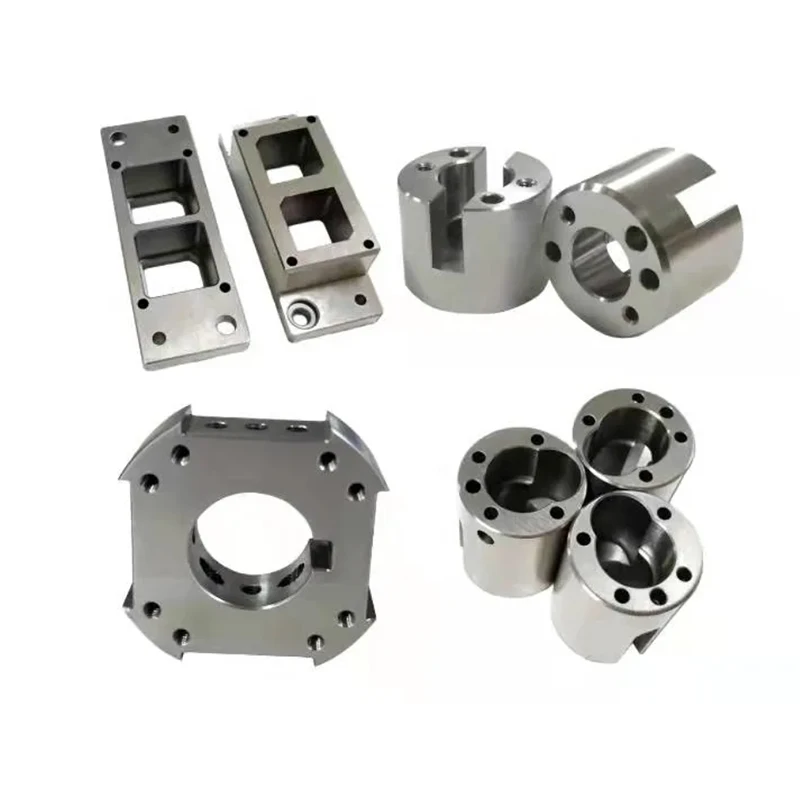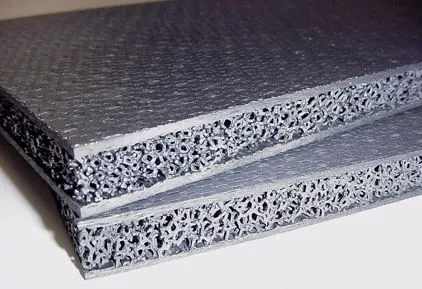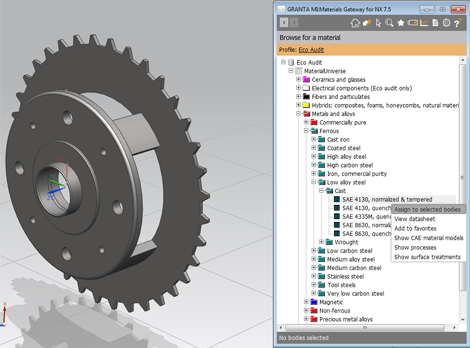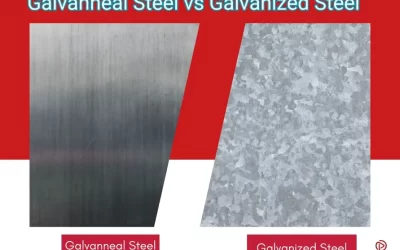Selecting the Right CNC Material
“CNC machining is a prominent and accurate production process in the industry. Almost every engineering material (metal, plastic, and composite) can be machined using a CNC machine to create the desired shape. However, choosing the right material for the intended result in every CNC machining project is essential. “

Selecting the right CNC material is a crucial decision in the manufacturing process. It impacts not only the quality and performance of the final product but also influences the machining process, cost, and turnaround time. With the vast array of materials available, understanding the critical factors in choosing the right CNC material is essential. This comprehensive guide aims to demystify the process, presenting practical insights and expert advice to make informed decisions.
Let’s go through the process of selecting the best material for CNC machining that meets all of the requirements for your product development.
Why Choosing the Right CNC Material Matters For Your Project?
The right material choice in a CNC machining project directly influences your final product’s functionality, durability, and aesthetic appeal. In contrast, an inappropriate material selection can lead to increased wear and tear, poor performance, or even project failure. This decision becomes even more critical when considering complex projects or those with specific requirements with minimal margin for error.
The implications of this choice extend beyond the immediate concerns of manufacturing. They also touch on long-term sustainability, cost-effectiveness, and compliance with industry standards.
Here are key reasons why choosing the suitable CNC material is crucial:
- Impact on Manufacturing Process: The chosen material affects the machining process, including the type of CNC machine used, tooling requirements, machining time, and overall complexity.
- Final Product Quality: Material properties such as strength, hardness, and thermal resistance directly influence the quality, durability, and performance of the final product.
- Cost Efficiency: Selecting the most suitable material optimizes costs by balancing raw material expenses with machining time and tool wear.
- Compliance and Standards: Different industries have specific regulations and standards that materials must meet, especially in sectors like aerospace, medical, and automotive.
- Environmental Considerations: Eco-friendly materials and efficient machining processes can reduce the environmental impact of manufacturing.
- Aesthetic and Functional Design: The material choice impacts the product’s appearance, feel, and function, aligning with design specifications and customer expectations.
- Lifecycle and Maintenance: Different materials have varying lifespans and maintenance requirements, affecting the long-term viability and upkeep of the product.
Material Properties and Their Impact on CNC Machining
The material properties impact how they interact with the machining process. Each material comes with a unique set of characteristics that can significantly impact the machining experience, as well as the functionality and longevity of the final product. The critical properties to consider are strength, durability, heat resistance, and thermal properties.
Strength and Durability
Strength and durability determine how well a material can withstand external forces without deforming or breaking. The strength of a material is measured in terms of tensile strength, yield strength, and impact strength. On the other side, durability may refer to its wear resistance, fatigue life, and long-term stability under various environmental conditions.
Table: Comparison of Material Strength and Durability
|
Material |
Tensile Strength |
Yield Strength |
Impact Strength |
Wear Resistance |
Fatigue Life |
|
Aluminum 6061 |
Medium |
Medium |
High |
Medium |
High |
|
Stainless Steel 304 |
High |
High |
Medium |
High |
High |
|
Titanium Grade 5 |
Very High |
High |
High |
High |
Very High |
|
Brass C360 |
Medium |
Low |
Low |
Medium |
Medium |
|
ABS Plastic |
Low |
Low |
Medium |
Low |
Medium |
|
Polycarbonate |
Medium |
Medium |
High |
Medium |
High |
|
Acetal (Delrin) |
Medium |
Medium |
High |
High |
High |
|
Nylon |
Medium |
Medium |
High |
High |
High |
|
Cast Iron |
High |
Medium |
Low |
Very High |
Low |
|
Copper C110 |
Medium |
Medium |
Medium |
Medium |
Medium |
|
Magnesium Alloy |
Medium |
Medium |
High |
Low |
Medium |
|
Tool Steel (A2) |
Very High |
High |
Medium |
Very High |
High |
|
Inconel 718 |
Very High |
High |
Medium |
High |
High |
|
Teflon (PTFE) |
Low |
Low |
Low |
Low |
Low |
|
Polyethylene (HDPE) |
Low |
Low |
High |
Low |
High |
|
Aluminum 7075 |
High |
High |
High |
Medium |
High |
|
Stainless Steel 316 |
High |
High |
Medium |
High |
High |
|
Bronze |
Medium |
Medium |
Low |
High |
Medium |
|
Zinc Alloy |
Medium |
Low |
High |
Medium |
Low |
|
Carbon Steel |
High |
High |
Medium |
High |
High |
|
Fiberglass |
Medium |
Medium |
High |
High |
High |
Heat Resistance and Thermal Properties
Heat resistance and thermal properties are critical considerations in selecting materials for CNC machining, particularly for components that will be subjected to high temperatures or considerable levels of friction.
These properties influence how a material reacts to heat, impacting thermal expansion, thermal conductivity, and its ability to withstand degradation or structural changes at elevated temperatures.
Materials with superior heat resistance and thermal properties are often essential in aerospace, automotive, and high-performance parts manufacturing.
The following are the Top Heat-Resistant Materials used in CNC machining projects;
- Inconel: Known for its exceptional heat resistance, Inconel is ideal for applications in extreme environments, such as jet engines and exhaust systems. It retains strength over a wide temperature range.
- Stainless Steel (e.g., 316, 310): High-grade stainless steels are known for good heat resistance, making them suitable for applications in the food industry and high-temperature processing environments.
- Titanium Alloys: Titanium has a high melting point and maintains its strength at elevated temperatures, making it ideal for aerospace and medical applications.
- Ceramics (e.g., Silicon Carbide, Zirconia): These materials exhibit excellent heat resistance and are used in kiln linings, high-temperature sensors, and heat exchangers.
- Tungsten: Known for having the highest melting point of all metals, tungsten is used in applications that require a material to remain strong at extremely high temperatures.
- Molybdenum: Exhibits excellent heat resistance and is often used in furnace applications, electronics, and as a support for high-temperature sintering.
- Nickel Alloys (e.g., Hastelloy): These alloys resist high temperatures and corrosion, making them suitable for chemical processing environments.
- Cobalt-Chrome Alloys: Widely used in high-temperature applications such as gas turbine blades and orthopedic implants due to their excellent strength and wear resistance at high temperatures.
- Graphite: Used in high-temperature applications due to its unique thermal expansion properties and ability to withstand extreme heat without deforming.
- PEEK (Polyether Ether Ketone): A high-performance thermoplastic with excellent heat resistance, used in applications in the aerospace, automotive, and chemical processing industries.
 CNC machined parts made with diverse materials
CNC machined parts made with diverse materials
Analyzing the Cost-Effectiveness of Different CNC Materials
The selection of materials for CNC machining is about more than their mechanical properties or suitability for the job. Equally important is their cost-effectiveness, which is critical in the manufacturing process and the overall success. Analyzing the cost-effectiveness of different CNC materials involves an examination of their cost relative to their quality and the long-term return on investment (ROI) these materials can offer.
Balancing Quality and Budget
The adage “you get what you pay for” often holds in manufacturing, but this doesn’t mean the most expensive material is always the best choice.
As my experience in manufacturing-product development,
” The key lies in finding the right balance between quality and cost. High-quality materials may offer better performance, longevity, and appearance with a higher price tag. Conversely, more affordable materials might reduce initial costs but could lead to increased expenses in the long term due to lower performance or shorter lifespan.”
Table: Cost vs. Quality Analysis of Popular CNC Materials
|
Material |
Approximate Cost |
Durability |
Machinability |
Aesthetic Quality |
Typical Applications |
|
Aluminum 6061 |
Low |
Medium |
High |
Good |
Consumer Electronics |
|
Medium |
High |
Medium |
High |
Medical Devices |
|
|
High |
Very High |
Low |
Excellent |
Aerospace |
|
|
Medium |
Medium |
High |
Excellent |
Decorative Items |
|
|
Low |
Low |
High |
Fair |
Prototypes, Toys |
|
|
Polycarbonate |
Medium |
High |
Medium |
Good |
Automotive Components |
|
Nylon |
Low |
Medium |
High |
Fair |
Industrial Applications |
|
Tool Steel |
High |
Very High |
Low |
Good |
Cutting Tools |
|
High |
Medium |
High |
Excellent |
Electrical Components |
|
|
Acrylic |
Low |
Low |
High |
Excellent |
Signage, Display Cases |
Long-Term ROI on Material Choices
When selecting materials for CNC machining, it’s essential to consider the long-term ROI. It involves looking beyond the upfront material costs and evaluating the overall value the material brings over its lifecycle. It is typically expressed as a percentage for a clear picture of the material’s profitability or cost-effectiveness.
The mathematical relation for calculating ROI can be described as
ROI(%)= (Total Cost of Material / (Net Profit from Material Choice−Total Cost of Material)) ×100.
Here, Net Profit from Material Choice is the revenue generated from the products made with the material minus the costs incurred during production (including machining, labor, maintenance, etc.). Total Cost of CNC Material includes the purchase cost of the material and any additional processing costs.
Consider the Machinability of Materials
Machinability refers to the ease with which a material can be cut, shaped, and finished in the machining process. It directly impacts factors such as production speed, tool wear, surface finish quality, and overall cost-efficiency of the manufacturing process. Materials with high machinability allow for quicker machining times and lower tool wear.
Understanding Machinability Scores
Machinability scores are assigned to materials based on their ease of machining compared to a standard. Typically, this standard is set by a commonly machined material, like free-cutting brass, which is often assigned a baseline machinability score of 100%. Materials are then rated relative to this benchmark.
Let’s see the machinability of common CNC materials;
Table: Machinability Scores of Common Materials
|
Material |
Machinability Score (%) |
Comments |
|
Free Cutting Brass |
100 |
It is the baseline for comparison and offers excellent machinability |
|
Aluminum 6061 |
90 |
Easily machined, prevalent in various industries |
|
Mild Steel |
78 |
Good machinability, widely used |
|
Stainless Steel 304 |
45 |
Challenging machine requires sharp tools |
|
Titanium |
20 |
Difficult to machine, often used in aerospace |
|
Inconel |
15 |
Tough to machine, used in high-temp applications |
|
Hardened Tool Steel |
10 |
Extremely challenging, causes significant tool wear |
|
Plastics (e.g., Nylon) |
60 |
Varies widely; generally good machinability |
|
Bronze |
80 |
Good machinability, used in bearings and bushings |
|
70 |
Good machinability but abrasive to tools |
Assessing the Suitability for the End-Use Application
In CNC machining, the suitability of a material for the intended end-use application is paramount. It involves matching the material properties with the application’s requirements and specific needs.
Material Selection for Different Industries
The choice of material varies significantly across industries, each with its unique standards, environments, and performance expectations.
Table: Industry-wise Material Suitability
|
Industry |
Preferred Materials |
Reason for Suitability |
|
Aerospace |
Titanium, Inconel, Aluminum |
High strength-to-weight ratio, corrosion resistance |
|
Automotive |
Aluminum, Steel, Plastics |
Durability, lightweight, cost-effectiveness |
|
Medical |
Stainless Steel, Titanium |
Biocompatibility, sterility, corrosion resistance |
|
Electronics |
Copper, ABS Plastic |
Electrical conductivity, insulation properties |
|
Construction |
Steel, Concrete |
Structural strength, durability |
|
Consumer Goods |
Plastics, Aluminum |
Versatility, aesthetic appeal |
Customization Potential of Materials
The ability to customize materials is a significant aspect of CNC machining, allowing for tailored solutions to meet specific application needs.
- Surface Treatments: Coatings, anodizing, or plating to enhance corrosion resistance, wear resistance, or aesthetic appeal.
- Heat Treatment: Altering the material’s microstructure to improve hardness, strength, or ductility.
- Alloying: Combining different metals to create alloys with specific properties tailored to application needs.
- Additive Manufacturing: Using 3D printing to create complex geometries that are difficult to achieve with traditional machining.

Custom Metal-matrix composite for CNC machining
Environmental and Safety Aspects
Environmental sustainability is a growing concern, and factoring in the environmental and safety aspects of CNC materials is crucial. It involves considering the ecological footprint of the materials themselves and their impact during the machining process and throughout the lifecycle. Sustainable materials should ideally have a lower environmental impact, be recyclable, or come from renewable sources. Additionally, ensuring the safety of these materials during handling and machining is essential for protecting workers and the environment.
Eco-Friendly Material Choices
Selecting eco-friendly materials in CNC machining involves considering factors like energy consumption during production, emissions, recyclability, and the sourcing of raw materials. The goal is to minimize the environmental impact while still meeting the technical requirements of the manufacturing process.
Table: Environmental Impact Ratings
|
Material |
Recyclability |
Energy Consumption in Production |
Emission During Machining |
Overall Environmental Impact Rating |
|
Aluminum |
High |
Moderate |
Low |
Moderate |
|
Stainless Steel |
High |
High |
Moderate |
Moderate-High |
|
Titanium |
Moderate |
High |
Low |
High |
|
Brass |
High |
Moderate |
Low |
Moderate |
|
Plastics (e.g., ABS) |
Low |
Low |
High |
Moderate-High |
|
Polycarbonate |
Moderate |
Low |
Moderate |
Low-Moderate |
|
Recycled Plastics |
High |
Very Low |
Low |
Low |
|
Wood |
High |
Very Low |
Low |
Low |
|
Biodegradable Plastics |
High |
Low |
Low |
Low |
|
Bamboo |
High |
Very Low |
Low |
Low |
Evaluating Supplier Quality and Material Availability
The success of CNC machining projects often hinges on the quality and availability of materials, which depends on the suppliers. Evaluating supplier quality and material availability is a critical process that ensures consistency, reliability, and efficiency in production. The right supplier provides high-quality materials that meet specifications and ensures timely delivery and stable pricing, which are crucial for project planning and budgeting.
Selecting a reliable supplier involves several key factors:
- Quality Assurance: The supplier’s commitment to quality, evidenced by certifications (like ISO) and quality control measures.
- Delivery Reliability: Consistency in meeting delivery timelines according to project schedules.
- Cost Competitiveness: Competitive pricing that aligns with market standards without compromising quality.
- Communication and Support: Responsiveness to inquiries and support during material selection and delivery processes.
- Material Availability: Ability to consistently provide a wide range of materials, crucial for projects with diverse material needs.
- Flexibility and Scalability: Check capability to handle varying order sizes and adapt to changing project requirements.
- Reputation and References: Positive feedback and testimonials indicate reliability & trustworthiness.
- Sustainability Practices: Commitment to environmentally friendly and ethical material sourcing and supply chain practices.
Addressing the Material Scarcity for CNC Machining Projects
Material scarcity in manufacturing necessitates innovative solutions. Strategies include exploring alternate materials with similar properties but higher availability and utilizing recycled or reclaimed materials as substitutes. Additionally, considering composite materials can provide comparable characteristics to scarce ones.
To further mitigate material scarcity, sourcing locally reduces reliance on global supply chains, enhancing sustainability. Advanced synthetics serve as viable alternatives to scarce natural resources. Moreover, redesigning parts to accommodate more readily available materials can be a practical approach to overcoming scarcity challenges.
Leveraging Technology and Expertise in CNC Material Selection
In the complex field of CNC machining, leveraging technology and expertise is essential for optimal material selection. The integration of advanced technologies like CAD/CAM software and the insights from machining experts play a pivotal role in determining the most suitable materials for specific applications.
The Role of CAD/CAM in Material Selection
Computer-Aided Design (CAD) and Computer-Aided Manufacturing (CAM) software are invaluable tools in the material selection process:
- Enhanced Material Database: CAD/CAM software often includes extensive material databases, providing detailed information on various materials.
- Simulation Capabilities: It allows for the simulation of machining processes with different materials, helping to predict outcomes like tool wear and final product quality.
- Optimization of Machining Parameters: The software can optimize machining parameters for selected materials, improving efficiency and reducing waste.
- Design for Manufacturability: CAD/CAM helps design parts optimized for manufacturability with chosen materials, reducing production challenges.
Read more about this:
- The Complete Guide to CNC Files and CAD Formats
- The Role of CAM Software in Modern Manufacturing
- The Implementation Process of CAM Software: A Step-by-Step Guide

Mapping the materials in CAD
Consulting with Machining Experts
Machining experts bring valuable insights into material selection based on their experience & knowledge of the industry. For example, engineer and material science experts at Prolean can consult for your CNC material selection task along with the actual machining.
- Experience-Based Knowledge: Experts’ vast experience with various materials can guide choosing suitable materials for specific applications.
- Understanding of Industry Trends: Experts keep up with the latest industry trends and material innovations, offering cutting-edge solutions.
- Custom Recommendations: They provide tailored advice based on the unique requirements of each project.
- Risk Mitigation: Expert insights help identify potential issues with material choices and mitigate risks early in the project.
By leveraging technology and expertise, you can ensure that their material selection is not only based on current needs but also forward-thinking, aligning with emerging trends and technological advancements in CNC machining.
Do You Need Assistance in Material Selection for Your CNC Project?
Navigating the complexities of material selection for CNC projects can be daunting, but you don’t have to do it alone. Prolean stands as your expert guide in this critical phase. Our team specializes in helping clients choose the ideal materials that align with their project requirements, balancing factors like functionality, cost, and durability.
At Prolean, we understand that the right material choice is the cornerstone of successful CNC machining. We provide comprehensive support, from initial material selection to the final stages of precise CNC machining services. Our expertise ensures that your project benefits from materials that fit the technical specifications and optimize efficiency and quality.
Prolean’s Material Selection Assistance Highlights
- Expert Consultations: In-depth discussions to understand your project needs and recommend suitable materials.
- Material Property Analysis: Assessing material properties to ensure they meet your application’s demands.
- Cost-Benefit Analysis: Providing insights into the cost-effectiveness of different material options.
- Customized Solutions: Tailored material choices that align with unique project requirements.
- Quality Assurance: Ensuring that materials meet high-quality standards for reliability and performance.
- Sustainability Considerations: Offering eco-friendly material options aligned with sustainable manufacturing practices.
- End-to-end Support: From material selection to precision CNC machining, ensuring seamless project execution.
With Prolean’s expertise and comprehensive support, your CNC project is set to achieve excellence from the material selection phase to the final product.
Summing Up
In conclusion, selecting the right CNC material is a complicated work that demands consideration of various factors. Understanding material properties such as strength, durability, and heat resistance is fundamental to ensuring the success of any CNC machining project. Each material brings its unique set of characteristics, making it imperative to align these properties with the specific requirements of the intended application. Furthermore, the balance between quality and budget is a crucial consideration, as is the long-term ROI of the material choice. Furthermore, the machinability of materials significantly influences the efficiency of the CNC machining process.
Finally, the role of technology and expertise in material selection, mainly using CAD/CAM software and consultation with machining experts, is indispensable. These resources provide invaluable insights and aid in making informed decisions. This comprehensive understanding makes selecting the right CNC Material seamless and ensures optimal performance, sustainability, and cost-effectiveness.
Read more:
- What is CNC Milling?
- Common Materials for CNC Machining
- CNC Materials Mastery: Exploring the Wide Range of Machinable Options for CNC Machines
FAQs
What are the primary considerations in selecting CNC materials?
Factors like material properties, cost, machinability, and end-use application play a critical role.
How does material choice impact CNC machining costs?
Material costs, machinability, and the complexity of the machining process affect overall costs.
Why is machinability important in material selection?
Machinability determines machining efficiency, tool life, and finished product quality.
Can the choice of material affect the environmental footprint of CNC machining?
Yes, selecting eco-friendly materials can minimize environmental impact.
How do suppliers influence CNC material selection?
Supplier reliability, material quality, and availability are key factors.
What role does technology play in selecting CNC materials?
CAD/CAM software aids in predicting material behavior and optimizing machining processes.




0 Comments